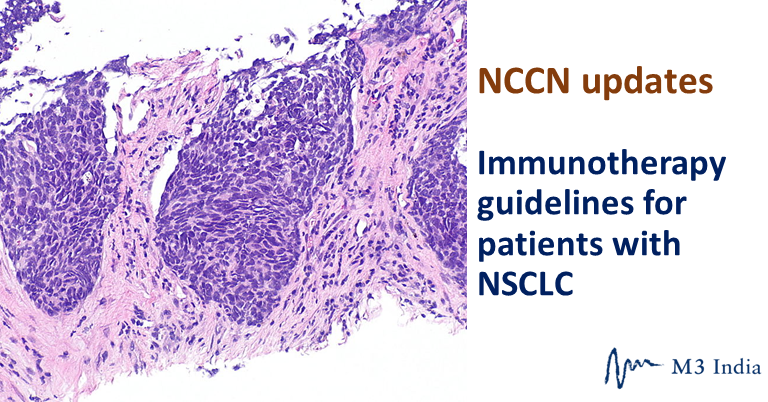NCCN updates immunotherapy guidelines for patients with NSCLC
M3 Global Newsdesk Jun 10, 2019
At the core of these guidelines, programmed death- 1 (PD-L1) expression remains the most significant factor in determining whether combination or single-agent therapy should be used. But other criteria should also guide immunotherapy strategy.

Immunotherapy has become an effective treatment strategy for patients with non-small cell lung cancer (NSCLC), but it’s not a one-size-fits-all treatment. So, at the 2019 National Comprehensive Cancer Network (NCCN) annual conference, an expert panel presented updated guidelines to direct clinicians in selecting the appropriate therapy for this patient population.
At the core of these guidelines, programmed death- 1 (PD-L1) expression remains the most significant factor in determining whether combination or single-agent therapy should be used. But other criteria should also guide immunotherapy strategy. Based on these guidelines, the classification below represents the most up-to-date approaches to treating NSCLC.
- Expression of PD-L1/PD-1: Expression of PD-L1/PD-1 protein is considered the key determinant for first-line immunotherapy because it opens up the possibility of using PD-1/PD-L1 inhibitors, which have proven effective in treating NSCLC. In its updated guidelines, the NCCN highly recommends testing for PD-L1/PD-1 expression in patients with NSCLC.
Of note, patients with EGFR or ALK mutations—even those with high PD-L1 expression—should not be given single-agent inhibitors as first-line therapy because these patients typically do not respond well to single-agent immunotherapy. Instead, patients with EGFR or ALK mutations should first receive targeted therapy, the NCCN advises.
- PD-L1 expression ≥ 50%: For patients with high PD-L1 expression, the NCCN strongly recommends single-agent as first-line treatment. Compared with chemotherapy, use of resulted in a more than twofold increase in median overall survival among patients with ≥ 50% PD-L1 expression. For high-level PD-L1 patients with high disease burden or high symptomatic burden, an alternative approach consisting of chemotherapy (carboplatin/) plus (or and ) may be more useful and offer higher response rates, according to the NCCN. Although toxicity is a greater concern with chemotherapeutic agents, clinicians can consider this double-barrel strategy for patients who may need the strongest therapy early on.
- PD-L1 expression < 50%, non-squamous cell: For patients with PD-L1 expression below 50%, treatment is different for patients with non-squamous cell carcinoma NSCLC than for those with squamous cell carcinoma (SCC) NSCLC.
For patients with non-SCC disease, the NCNN does not recommend a single - agent as front-line treatment, despite FDA approval in this setting. Rather, treatment with / in combination with either cisplatin or carboplatin is the preferred approach. In the KEYNOTE-189 trial, on which this recommendation is based, this combination therapy resulted in a 51% reduced risk of death chemotherapy alone.
Another first-line therapy for patients with non-SCC NSCLC is a four-drug combination regimen of , carboplatin, paclitaxel, and bevacizumab, especially for patients ineligible for . In the Impower150 trial, non-SCC NSCLC patients treated with this combination therapy demonstrated a 22% reduction in risk of death compared with chemotherapy alone.
- PD-L1 expression < 50%, squamous cell: For patients with SCC NSCLC and PDL1-expression < 50%, the NCCN’s primary recommendation is to administer / in addition to either or nab-paclitaxel. In these cases, PD-L1 expression does not impact the anticipated benefit.
- Patients with driver mutations: As noted above, patients with EGFR or other driver mutations do not respond well to single-agent immunotherapies. Some evidence has shown that bevacizumab in combination with chemotherapy (carboplatin/paclitaxel) and can improve outcomes for patients with EGFR/ALK-positive disease, after completion of appropriate targeted therapy. However, this combination therapy is not yet approved by the FDA for patients with EGFR- and ALK-positive disease.
The guidelines also emphasise the importance of managing immune-related toxicities following treatment, which may lead to discontinuing therapy if the toxicity is severe. The NCNN recommends the use of steroids (1-2 mg/kg/d) for toxicities of grade 2 and above. Moreover, because is the most frequently encountered toxicity associated with NSCLC treatment, the NCCN guidelines advise permanent discontinuation of the immunotherapy if a grade 3-4 occurs. Treatment of may include the use of immunosuppressive drugs.
Overall, the NCNN recommendations highlight the need to examine patients on a case-by-case basis and utilize PD-L1 expression, histology, and presence of confounding mutations in determining the best treatment approach. Following treatment, clinicians should monitor their patients for onset of new symptoms or worsening conditions.
This story is contributed by Soha Mahmoud and is a part of our Global Content Initiative, where we feature selected stories from our Global network which we believe would be most useful and informative to our doctor members.
-
Exclusive Write-ups & Webinars by KOLs
-
Daily Quiz by specialty
-
Paid Market Research Surveys
-
Case discussions, News & Journals' summaries
